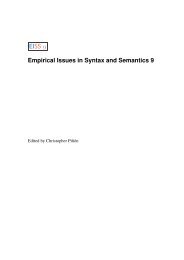228 Balázs Surányiloosened up to get <strong>the</strong> fact right, and finally we have seen some conceptual arguments against <strong>the</strong>RefP and <strong>the</strong> DistP analysis.Let me now point out some specific cases where <strong>the</strong> Beghelli and Stowell account fails to bedescriptively adequate. One case of undergeneration we have already seen illustrated in (24), withtwo distributive universals and an interfering o<strong>the</strong>r quantifier.A second case in point is (26), which is essentially analogous to our earlier example (4a).(26) Four students read three books 12 S > O / O > SGiven that Beghelli and Stowell assume that, first, an object bare numeral indefinite never movesabove <strong>the</strong> subject position, and second, that bare numeral indefinites do not reconstruct to <strong>the</strong>ir baseposition, it follows that only direct scope is generated for such examples. However, as Beghelli(1993: 66), Liu (1997: 41) and Reinhart (1997: 369) note, inverse distributive scope is in factavailable.A third case is illustrated by (27).(27) Less <strong>the</strong>n four students read exactly three books S > O / *O > SLiu (1997: 18)In (27), inverse distributive scope is unavailable. Given that modified numeral indefinites are ableto reconstruct back to VP, on Beghelli and Stowell’s assumptions we expect such inverse scope tobe available. We saw that it is indeed available in some cases, such as (7) above, repeated as (28).(27) <strong>the</strong>n involves overgeneration.(28) More than three men read more than six books S > O / ?O > SA fourth case involves internal arguments. Consider (29a):(29) a. Mike showed five films to every guestb. [DistP every … [AgrOP five [VP …five…]]]]Beghelli and Stowell’s system predicts that <strong>the</strong> VP-internal QPs involved in such a sentence typecan occur at LF as schematized in (29b). The direct object raises to DistP, while <strong>the</strong> indirect object,being a bare numeral indefinite, cannot raise higher than AgrOP. This predicts that only an inversescope reading should exist between <strong>the</strong>se two expressions—this is contrary to fact: a ra<strong>the</strong>rprominent reading of (29a) is one with direct scope. This reading fails to be generated for (29).A last example involves overgeneration again. In (30a) we have a sentence with two modifiednumeral indefinites and a universal quantifier. One LF-representation generated by Beghelli andStowell’s model is (30b). This corresponds to <strong>the</strong> scope relations with DO scoping over IO in turnscoping over <strong>the</strong> Subj. Such scope relations, however, don’t actually obtain for (30a) type examples.12 Beghelli (1993) provides <strong>the</strong> following context to make inverse scope less dispreferred. “Classes in this departmentare becoming incredibly tough; it has gotten to <strong>the</strong> point where maybe three students would pass. Last month has been<strong>the</strong> worst ever: two students passed four classes.”It appears considerably easier to get <strong>the</strong> distributive inverse scope reading too if we make <strong>the</strong> direct scope readingpragmatically implausible:(i)In <strong>the</strong> gigantic polygamous wedding ceremony, two women married one hundred men
Differential Quantifier Scope: Q-Raising versus Q-Feature Checking 229(30) a. Exactly two teachers showed less than five tree diagrams to every studentb. [AgrSP exactly 2 [DistP every [AgrOP less than five [VP … ]]] S> IO > DOIn fact, similarly to (27), Beghelli and Stowell generate DO > S scope relations, erroneously. Evenif we stipulate (on <strong>the</strong> basis of sentences like (27) and <strong>the</strong> present example) that in certain cases—including (27) and (30)—<strong>the</strong> modified numeral in subject position cannot reconstruct across <strong>the</strong> DOmodified numeral for some reason, we would <strong>the</strong>n only generate a S > IO > DO scope order, o<strong>the</strong>rscope orders would not be generated. This is because <strong>the</strong> IO every-quantifier must be located inDistP, its position being fixed. If <strong>the</strong> subject modified numeral expression cannot reconstruct, as wewould be assuming, <strong>the</strong>n <strong>the</strong> only scope order, once again, is: S > IO > DO. This means that inBeghelli and Stowell’s system, stipulating that <strong>the</strong> subject cannot reconstruct in cases like (27) and(30) does not help: ano<strong>the</strong>r prominent available scope order, namely IO > S > DO, would still bemissed.To sum up, we have seen that <strong>the</strong> Q-checking approach to Q-scope faces severe challenges.Not only Hungarian fails to provide any evidence in favour of such an approach, but also, positingRefP and DistP projections creates acute problems of both a conceptual and an empirical nature. In<strong>the</strong> last subsection I established that unfortunately, <strong>the</strong> descriptive coverage of <strong>the</strong> account itselfalso leaves much to be desired.5. A QR-based approachI will demonstrate now that a model incorporating Quantifier Raising, when augmented withindependently motivated assumptions of existential closure over choice function variables (cf.Section 2.1 above) and A-reconstruction, is able to provide a more constrained, and at <strong>the</strong> sametime empirically superior account of differential Q-scope.In general terms, I believe that as a methodological ideal it would be appealing to connect <strong>the</strong>differential scope-taking options of quantifier classes to <strong>the</strong>ir lexical semantic characterization, inparticular, to relate <strong>the</strong>ir semantic characterization to <strong>the</strong> different mechanisms of scope-taking that<strong>the</strong>y can participate in. In a broad sense, this methodological stance is <strong>the</strong> same as <strong>the</strong> one taken inBeghelli and Stowell’s / Szabolcsi’s work.In what follows, I will first lay out <strong>the</strong> assumptions I adopt. These assumptions have beenindependently argued for, and I will argue that, when combined, <strong>the</strong>y yield precisely <strong>the</strong> complexinteraction patterns reviewed above. The central one of <strong>the</strong>se assumptions is that QR exists as amovement serving purely scope-shifting, and that it applies to GQ-NPs.5.1. Bare numeral indefinites: closure and A-reconstructionFirst, following a Heimian treatment, <strong>the</strong> class of bare numeral indefinites 13 , being open expressionswith an unbound restricted variable, can be bound under closure. For concreteness, I adoptReinhart’s choice function approach here, but <strong>the</strong> particular choice among <strong>the</strong> closure approacheswill not play a role here.Bare numerals are taken to be cardinality predicates, following Milsark’s (1977) analysis ofDefiniteness Effect contexts. Bare numeral cardinality predicates are second order predicates13 The class of bare numerals may be understood to also contain <strong>the</strong> indefinite article a(n), or alternatively, this articlemay be taken to be a semantic determiner creating generalized quantifiers. This choice does not matter for our purposes.











